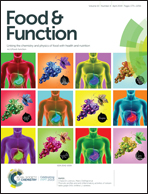Effect of protein composition of a model dairy matrix containing various levels of beta-casein on the structure and anti-inflammatory activity of in vitro digestates
Abstract
An increasing body of evidence demonstrates that differences in protein composition in the food matrix can significantly affect its biological functionality. The present research hypothesized that a matrix containing the same level of dairy protein, but with different composition, even when showing similar properties during digestion, may have a different biological functionality. To test this hypothesis, three matrices, containing 2.8% protein and similar amounts of fat and solid were prepared, either with 100% whey proteins, or with a ratio of caseins to whey protein of 40 : 60, but differing in β-casein ratio. The mixtures were subjected to in vitro digestion, and the digestates were used in uptake experiments using Caco-2 cell monolayers. The basolateral fraction metabolized by the cells was used to stimulate human LPS-stimulated THP-1 macrophages and the concentration of selected cytokines were measured, as an indication of potential differences in biological functionality between the different dairy matrices. All three digestates induced a significant reduction in IL-1β cytokines, with the casein-containing treatments inducing a greater decrease compared to that containing only whey proteins. The matrix containing the highest ratio of β-casein induced the lowest secretion of proinflammatory cytokines TNF-a and IL-6. This study demonstrated that milk protein composition does not only affect the rate of gastric proteolysis and structure of the gastric digestate, but will cause differences in physiological effects. This research stressed the role of milk protein components during digestion, and of β-casein in particular, and their potential to modulate biological functions in the gastrointestinal tract.



 Please wait while we load your content...
Please wait while we load your content...